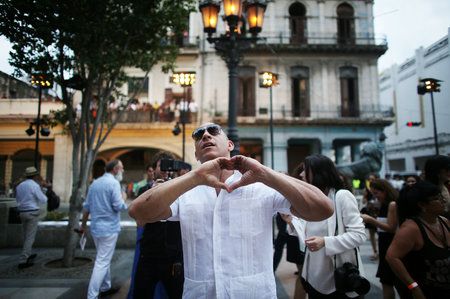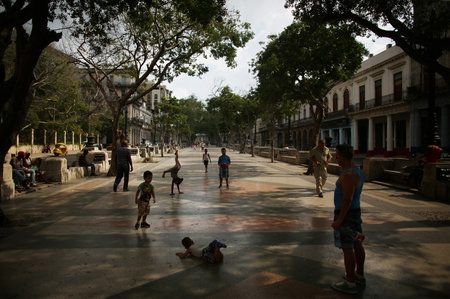Advertisement
Chanel brings glamor back to Cuba in catwalk extravaganza
By Sarah Marsh
HAVANA (Reuters) – French fashion house Chanel brought glamor back to Communist-ruled Cuba on Tuesday in a runway show on one of Havana’s main boulevards, featuring glittering gowns, tulle cocktail dresses and models in Panama hats smoking cigars.
Chanel is the first major fashion house to hold a runway show in Cuba, highlighting both warming relations with the West and new inequalities on the island.
Former Cold War foes the United States and Cuba formally agreed to restore diplomatic relations last July.
Celebrities, including actress Tilda Swinton and supermodel Gisele Bundchen, jetted into the Caribbean island for the show that evoked the elegance of pre-revolutionary Cuba, arriving at the venue in vintage convertibles.
The Cuban contingent included former President Fidel Castro’s grandson Tony, an aspiring model, which raised some eyebrows, given the leader’s railings against capitalism.
“It is an honor for all Cubans for this big event to take place here,” said Castro, 17, whose grandfather was also known for his good looks as a young revolutionary.
Karl Lagerfeld, who has been at Chanel’s creative helm since 1983, has said his latest inter-seasonal Cruise collection was inspired by the “cultural richness and opening up of Cuba.”
Cuban motifs in the new Cruise line were exemplified in a fabric depicting turquoise and pink vintage cars used for leisurewear such as jackets, a bathrobe and skirts.
Sequined black berets also recalled the non-glitzy one sported by late revolutionary hero Ernesto “Che” Guevara, a national hero in Cuba.
By showcasing its Cruise collection in Cuba, Chanel has said it was harking back to the roots of the line, originally designed for wealthy Americans holidaying on yachts and cruises in the Caribbean to escape the winter gray.
U.S. cruises to Cuba were forbidden during the country’s standoff with the United States. On Monday, the first U.S. cruise ship to sail to the island since Castro’s 1959 revolution docked in the capital.
U.S. President Barack Obama is also chipping away at curbs on travel to Cuba.
“We have been banned from Cuba, so getting to come here before it really changes, and seeing the show, was pretty epic,” said one of the guests, Loïc Villepontoux, on his way to the afterparty in Havana’s Cathedral Square.
Lagerfeld, 82, is known for his lavish show settings and has created a mock casino, supermarket and brasserie in the past.
This time, he let the faded glamor of Havana, once a wealthy port, speak for itself.
During a 25-minute show set to live Cuban music, his models strutted down a 160-meter (525-foot) section of the leafy Paseo del Prado, lined with ornate street lamps and bronze lions.
Some Cubans criticized Chanel, the second-biggest luxury brand behind LVMH’s Louis Vuitton, for choosing to showcase its new line in a country starved of material opulence.
Chanel goods, which can cost tens of thousands of dollars, are not sold in Cuba and most citizens could not even dream of affording them. About 70 percent of Cuban workers work for the state, on an average salary of $25 every month.
Others said the show gave their dreams wings to fly.
“Just because I can’t afford it doesn’t mean I want to deny others that luxury,” said accountant Marilia Veliz, 44.
“And who knows, maybe one day. It’s important to dream.”
(Additional reporting by Nelson Acosta; Editing by Marguerita Choy and Clarence Fernandez)

























